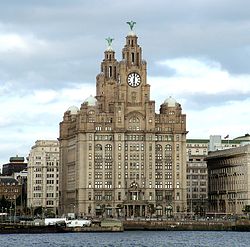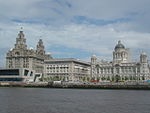Royal Liver Building
 From Wikipedia - Reading time: 12 min
From Wikipedia - Reading time: 12 min
| Royal Liver Building | |
|---|---|
 Royal Liver Building, Pier Head, Liverpool | |
 | |
| Alternative names |
|
| General information | |
| Type | Commercial offices |
| Location | Pier Head, Liverpool, England, United Kingdom |
| Coordinates | 53°24′21″N 2°59′45″W / 53.4058°N 2.9958°W |
| Construction started | 1908 |
| Completed | 1911 |
| Cost | £800,000 |
| Owner | Corestate Capital |
| Height | |
| Architectural | 98.2 m (322 ft) |
| Roof | 50.9 m (167 ft) |
| Technical details | |
| Floor count | 13 |
| Lifts/elevators | 12 |
| Design and construction | |
| Architect(s) | Walter Aubrey Thomas |
| Main contractor | Edmund Nuttall Limited |
| Designations | |
Listed Building – Grade I | |
| Official name | Royal Liver Building |
| Designated | 12 July 1966 |
| Reference no. | 1356370 |
| References | |
| [1][2][3][4] | |
The Royal Liver Building /ˈlaɪvər/ is a Grade I listed building in Liverpool, England. It is located at the Pier Head and along with the neighbouring Cunard Building and Port of Liverpool Building is one of Liverpool's Three Graces, which line the city's waterfront. It was also part of Liverpool's formerly UNESCO-designated World Heritage Maritime Mercantile City.
Opened in 1911, the building was the purpose-built home of the Royal Liver Assurance group, which had been set up in the city in 1850 to provide locals with assistance related to losing a wage-earning relative. One of the first buildings in the world to be built using reinforced concrete, the Royal Liver Building stands at 98.2 m (322 ft) tall to the top of the spires, 103.7 m (340 ft) to the top of the birds and 50.9 m (167 ft) to the main roof.
The Royal Liver Building is one of the most recognisable landmarks in the city of Liverpool with its two fabled Liver Birds, which watch over the city and the sea. Legend has it that if the two birds were to fly away, the city would cease to exist.
The Liver Birds are 5.5 m (18 ft) high. Their added height gives the Royal Liver Building an overall height of 103.7 m (340 ft). A building of skyscraper proportion that was once one of the tallest buildings in the country, the Royal Liver Building is currently the fourth-tallest building in Liverpool.
History
[edit]In 1907, the Royal Liver Group had over 6,000 employees. Given the need for larger premises, the company approved the construction of a new head office. The building was designed by Walter Aubrey Thomas; the foundation stone was laid on 11 May 1908 and just 3 years later, on 19 July 1911, the building was officially opened by Lord Sheffield.[5] The building is an early example of a building constructed using reinforced concrete,[6] and given the building's radical design was considered by some to "be impossible to build".[5]
During the early 1950s, the sixth floor was occupied and used by No 3 Movements Unit (Embarkation) of the Royal Air Force, overseeing and controlling the movement of RAF personnel and goods through the port.[citation needed] In 1953, electronic chimes were installed to serve as a memorial to the members of the Royal Liver Friendly Society who died during the two World Wars. During hours of darkness, the clock dials are illuminated.[citation needed]
The building remained the head office for Royal Liver Assurance until its merger with Royal London Group in 2011.[citation needed]
In October 2016, the building was put up for sale for the first time in its history.[7] The owner instructed CBRE Group to list the sale with a guide price of more than £40m.[8] In February 2017, Luxembourg-based investment group, Corestate Capital, bought the building for £48 million along with Everton F.C. majority shareholder Farhad Moshiri. Moshiri planned to run Everton's affairs from the building and have his own office to include a view of the new stadium on Bramley Moore Dock.[9]
In 2019, as part of a larger repositioning of the building, a visitor attraction was opened giving the public the chance to tour the West Clock Tower of the building on a regular basis for the first time in its then 108 year history.[10] Previously this had only been open to the public during Heritage Open Days, which have been running during September each year since 1994.[citation needed]
Description
[edit]
The building overlooks the River Mersey from its waterfront location on the Pier Head and forms one of the 'Three Graces' along with the Port of Liverpool Building and the Cunard Building. This is reflected in the building's Grade I listed building status.[citation needed] It has 13 floors. The Liver birds are 5.5 metres,18 feet tall. Crowning, they give they give the skyscraper a height of 103.7 metres, 340 feet.[citation needed]
The building is crowned by a pair of clock towers: as a ship passed along the river, mariners could tell the time from these. The clocks were made by Gent and Co. of Leicester.[11] The clock faces are 7.6 m (25 ft) in diameter, larger than those of London's famous landmark, the Great Westminster Clock, holding the distinction of being the largest electronically driven clocks in the UK.[12] The four clock faces have no numerals, only facets indicating the 12 hours. These are disposed as three on the riverside tower, facing west/north/south, the remaining one on the landward tower facing east. There is only one mechanism driving the faces on both of the towers. They were originally named George clocks, because they were started at the precise time that King George V was crowned on 22 June 1911.[13]
Atop each tower stand the mythical Liver Birds, designed by Carl Bernard Bartels. The birds are named Bella and Bertie, looking to the sea and inland, respectively.[14] Bella may possibly be named for Isabella of Angoulême, the queen consort of King John, when Liverpool was granted its royal charter. Bertie may possibly be named for Edward VII (known as Bertie to the royal family) who was King of the United Kingdom of Great Britain and Ireland at the time of the building's construction.[citation needed] Popular legend has it that while one giant bird looks out over the city to protect its people, the other bird looks out to sea at the new sailors coming in to port. Alternatively, local legend states one Liver Bird is male, looking inland to see if the pubs are open, whilst the other is female, looking out to sea to see if there are any handsome sailors coming up the river.[15]
It is also said that, if one of the birds were to fly away the city of Liverpool would cease to exist, thus adding to the mystery of the birds.[citation needed] As a result, both birds are chained to the domes upon which they stand; although this could simply be because the originally gilded Liver birds, of a moulded and hammered copper construction (that is itself fixed onto a rolled-steel armature) are eighteen feet high, ten feet long and themselves carry in their beaks an intricately cast sprig of seaweed.[citation needed] Additionally, however, their heads are three-and-a-half feet long, their wing spread is twelve feet and their legs measure two feet in circumference.[citation needed] The two birds – officially cormorants – have identical and almost traditional poses, standing upright with half-raised wings.[citation needed]
Tenants
[edit]This section needs additional citations for verification. (November 2020) |
There are currently over 19 tenants in the Royal Liver Building including:
- Evelyn Partners
- Axia Group
- Open Media
- Culture City
- Everton FC
- Grant Thornton
- HSBC
- ITV[16]
- Mott MacDonald
- The Venue at the Royal Liver Building
- Pershing
- Elliot Wakefield Inc.
- Princes Group[17]
- Publiship[18]
- Cloud Jungle
- SportPesa[19]
- USS
- Royal Liver Building 360 – a visitor attraction
- Liverpool Vaults & Liverpool Bullion
- Aesthetics of The Royal Liver Building
- Primas Law
- Barnett Waddingham
Gallery
[edit]-
The Royal Liver Building - Liverpool Mathew Street Music Festival 2006
-
Liver birds tower over Dale Street and the Town Hall
-
The Royal Liver Building, seen from the nearby Atlantic Tower
-
The riverside tower
-
One of the two Liver Birds that sit atop each tower of the building
-
The Royal Liver Building is floodlit at night
-
Drone photo of one of the Liver Birds on the Royal Liver Building, Liverpool
See also
[edit]Notes
[edit]References
[edit]- ^ "Royal Liver Building". CTBUH Skyscraper Center.
- ^ "Emporis building ID 110844". Emporis. Archived from the original on 7 March 2016.
{{cite web}}: CS1 maint: unfit URL (link) - ^ "Royal Liver Building". SkyscraperPage.
- ^ Royal Liver Building at Structurae
- ^ a b "Rapid Growth 1886-1913". Royal Liver Group. Archived from the original on 21 November 2008. Retrieved 29 September 2008.
- ^ Hughes, Quentin (1999). Liverpool: City of Architecture. The Bluecoat Press.
- ^ "Liverpool's Royal Liver building is put up for sale". BBC News. 17 October 2016. Retrieved 18 October 2016.
- ^ Dunn, Connor (17 October 2016). "The Royal Liver Building to be put on sale for the first time in its history". Liverpool Echo. Retrieved 18 October 2016.
- ^ Houghton, Alistair (8 February 2017). "The Royal Liver Building sold for £48 million". Liverpool Echo. Retrieved 8 February 2017.
- ^ Royal Liver Building 360
- ^ "The story of the Royal Liver Building and the people who shaped the organisation behind it" (PDF). Friends of Royal Lyver. p. 9. Archived from the original (PDF) on 24 September 2015. Retrieved 22 November 2015.
- ^ "Port Cities: The Royal Liver Building". E. Chambré Hardman Archive. Archived from the original on 29 January 2008. Retrieved 1 February 2008.
- ^ "Coast Walk: Stage 4". BBC Liverpool. 21 July 2005. Retrieved 1 February 2008.
- ^ Coen, Susie (25 September 2016). "Seven things you didn't know about our Liver Birds". Liverpool Echo. Retrieved 18 October 2016.
- ^ "Imagine Our City Without Them! Everything you need to know about our beloved Liver Birds". theguideliverpool.com. 8 July 2018. Retrieved 5 November 2020.
- ^ "ITV". itv.com.
- ^ McDonough, Tony (13 January 2015). "Liverpool food group Princes sees profits up by £8m as it takes total control of Napolina". Liverpool Echo. Retrieved 18 October 2016.
- ^ "Home". Publiship. Retrieved 18 October 2016.
- ^ O’Keeffe, Greg (4 May 2017). "Everton's next sponsor to move European HQ to Liverpool waterfront". Liverpool Echo. Retrieved 21 April 2018.
 KSF
KSF









